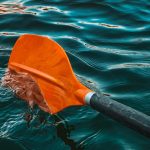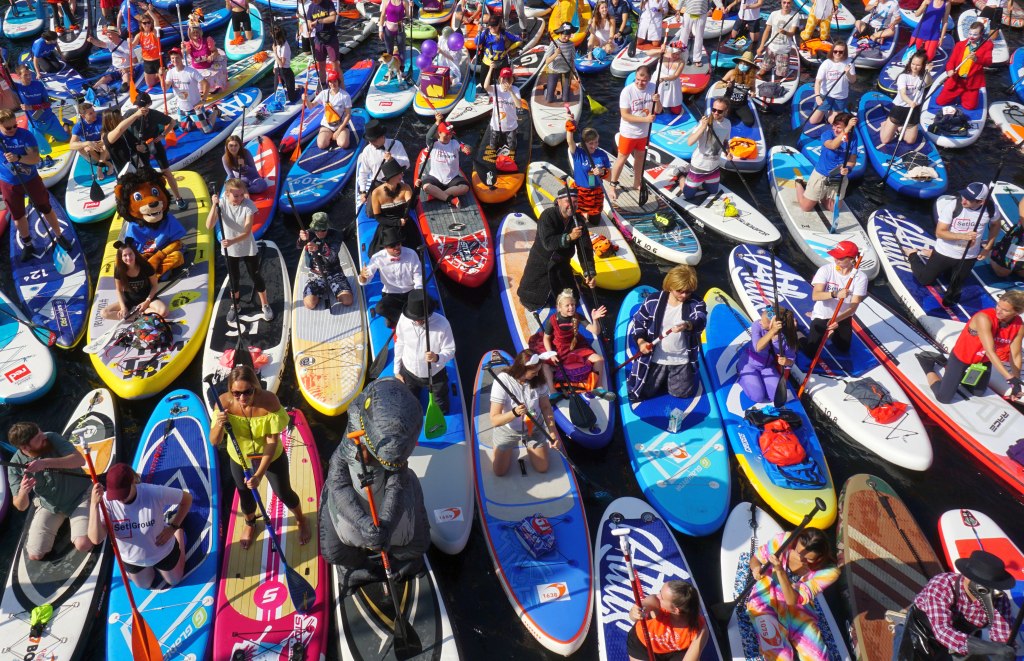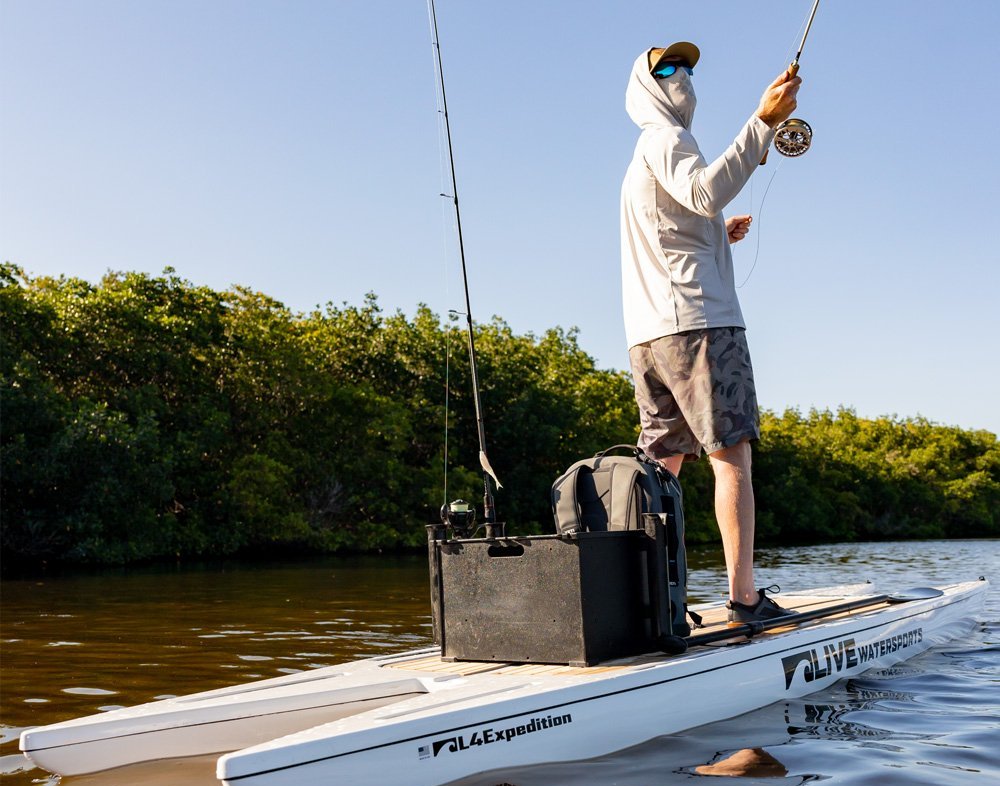Switching a paddleboard to a kayak (and back again) in a few seconds? Yes, please! Andrew Peloquin shares his hands-on test of Isle Switch 2 in 1 Inflatable Kayak & Paddle Board Package.

When choosing a paddle board, the best place to start is looking at the board’s construction, whether a hard shell or inflatable.
Each has its pros and cons, their weaknesses and strengths. That’s what I want to address in this article.
We’ll take a closer look at what purpose each paddleboard serves, and which will be the right choice for you based on their differences.
So, an inflatable paddle board or a solid one, which is the best? Let’s find out.
Quick Answer: Which is Better, an Inflatable or a Solid Paddle Board?
Inflatable SUPs are more budget-friendly, stable, can accommodate heavier paddlers and more gear, and are significantly more portable—all great options for SUP Yoga, fishing, or recreational use.
On the other hand, solid paddle boards are likely to last longer, handle better, are more versatile, and provide a rigid platform better suited for racing, touring, and SUP surfing.
Hard-Shell vs. Inflatable Paddle Boards: What are the Differences?
Materials

What Are Hard-shell Paddle Boards Made From?
Hard-shell SUPs are usually made from:
- Thermoplastic/rotomolded plastic. These tend to be cheaper and heavier but also very sturdy. They can withstand significant impact and a great deal of scuffing and scraping. You’ll find a lot of whitewater SUPs are made using these plastic types, as are many recreational and surfing SUPs.
- Wood. The original SUPs crafted by the Hawaiian islanders were made from wood. It was primarily koa wood, bamboo, cedar, and even pine. Many modern wooden SUPs have a hollow-core design with an empty, air-filled center to decrease the board’s weight.
- Foam. Some hard-shell boards are made to be softer, so they use absorbent foam. Foam is also used in the boards’ core to add buoyancy and is wrapped in plastic, fiberglass, or carbon fiber layers.
- Fiberglass. Fiberglass bonded with epoxy resin is very lightweight and stiff, which makes it a perfect material for racing and touring boards. However, it’s not the toughest of the hard-shell materials.
- Carbon fiber. Carbon fiber is very lightweight and insanely tough, so it’s great for building tougher, stiffer racing, touring, and even high-end surf SUPs. However, it’s a very expensive material.
What Are Inflatable Paddle Boards Made From?
Inflatable SUPs are typically made using some form of polycarbonate or PVC, materials that are flexible enough to expand when inflated but become stiff and rigid enough to form a solid platform to stand on.
Many modern inflatables are made using military-grade PVC and may be treated with special coatings to make them resistant to UV damage, abrasion, scratches, and punctures.
Drop-stitch technology is also becoming more common in mid- and high-end inflatable SUPs. Essentially, hundreds of tiny threads are used to join the two layers of material together. While this adds a bit of weight, it creates a much firmer bond and increases the durability of the board.
Durability
No material used for crafting paddle boards can compare to the durability of thermoplastic or rotomolded polyethylene. Many kayaks and SUPs made using the material joke about being “bomb-proof” because of how insanely tough the plastic is.
Both types of plastic can withstand significant amounts of abrasions and direct impacts without damage. That’s why they’re often used for building hard-shell SUPs intended for whitewater paddling use (as well as recreational use or use by kids).
Carbon fiber is also very tough—it’s said to be up to five times more resilient than steel, pound for pound—and can survive a beating. It’s probably the most durable material used to build hard-shell SUPs.
However, carbon fiber is so expensive that only high-end SUPs are built from it.
Wood is also a fairly durable material. Most of the wood used is naturally oil-rich and treated with oil so it’s resistant to the sort of water damage you’d expect to be a threat. However, wood is less resilient against abrasions and may be more likely to crack or splinter over years of use.
Fiberglass, on the other hand, is far from tough. Many a fiberglass board has been known to crack from a direct impact. That’s why fiberglass is typically used for racing and touring boards, where you’ll be largely on open water with little risk of any obstacles damaging the boards.
How Durable Are Inflatable Paddle Boards?
In the past, inflatable SUPs were made using cheaper forms of PVC and plastic that were easily punctured, damaged by abrasions, and even deformed by direct impacts. The first models—especially the cheap ones—were far from durable.
However, over the years, inflatable SUPs have become much tougher. Now they’re built using high-quality PVC that can take a beating without showing signs of wear and tear.
Modern inflatable SUPs, especially the mid- and high-end boards, are easily on par with the majority of hard-shell SUPs. They can handle direct impacts with more resilience than fiberglass and won’t risk splintering or cracking like wooden SUPs.
Though they can never be quite as tough as carbon fiber, I’ve found their durability puts them almost on par with plastic SUPs.
Sure, they’ll require some maintenance, but with the proper care, you’ll find they can last you easily as long as a hard-shell SUP.
Rigidity
The rigidity of an SUP matters a lot more than you’d think!
You want a solid, stiff platform to stand on when you’re paddling. Higher rigidity, after all, contributes to higher stability.
You’ll also push against that platform with your feet with every stroke of the paddle, so the more rigid it is, the more solid your base and the more power you can drive into each paddle stroke.
A board that bends or sags will also be less streamlined, so your board will go slower and require more effort of you to steer and handle.
Hard-shell boards are also called “rigid boards” because they’re exactly that: entirely stiff and rigid. There is no bend or flex in the material whatsoever. They create a perfectly solid platform that provides a stable base for you to stand on.
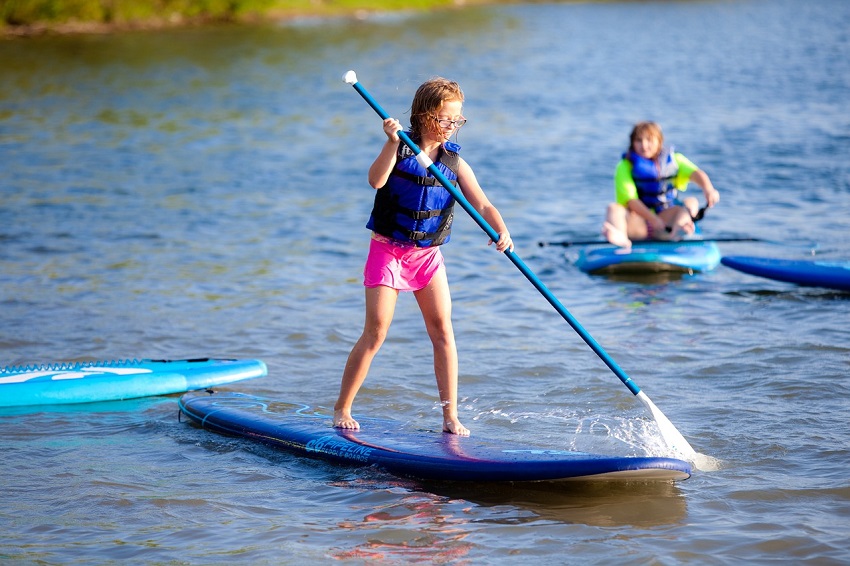
Inflatable SUPs are less rigid by nature—after all, the material is designed to have enough flex to expand and accommodate the air you’re using to inflate it.
However, once the SUPs are inflated to the correct pressure (13 to 17 PSI, depending on the model), the platform is as rigid as the hard-shell SUPs.
If there is any sag or bend in your inflatable SUP, the likely reasons are:
- you failed to inflate it to the proper PSI fully, or
- air is leaking from a puncture or tear, and the pressure is slowly decreasing.
Both of these are fairly easy to fix!
Though the material used to construct the SUPs is flexible and bendable, the high-pressure inflation creates a structure as rigid as any hard-shell SUP.
Weight
This is where the inflatable SUP takes a very significant lead!
The average inflatable SUP (between 10 and 11.5 feet long) weighs around 20 pounds, give or take a few. Larger SUPs will weigh more, but it’s an incremental increase in weight.
Some inflatable SUPs will weigh slightly more than average because of specific technologies used in their construction:
- Drop-stitching. All those hundreds of threads stitching the upper and lower layers of material together will add extra weight.
- Dual- and triple-layer materials. More layers of material mean higher weight.
- Military-grade PVC. Some (but not all) military-grade PVC boards are heavier because the material may be slightly thicker or treated with a coating to add resiliency.
- Stiffening system. Some inflatable SUPs incorporate extra materials around the board’s sides to reinforce the seams and create additional stiffness.
In my research, I have yet to find a single-person inflatable SUP (under 12’ long) that weighs more than 30 pounds.
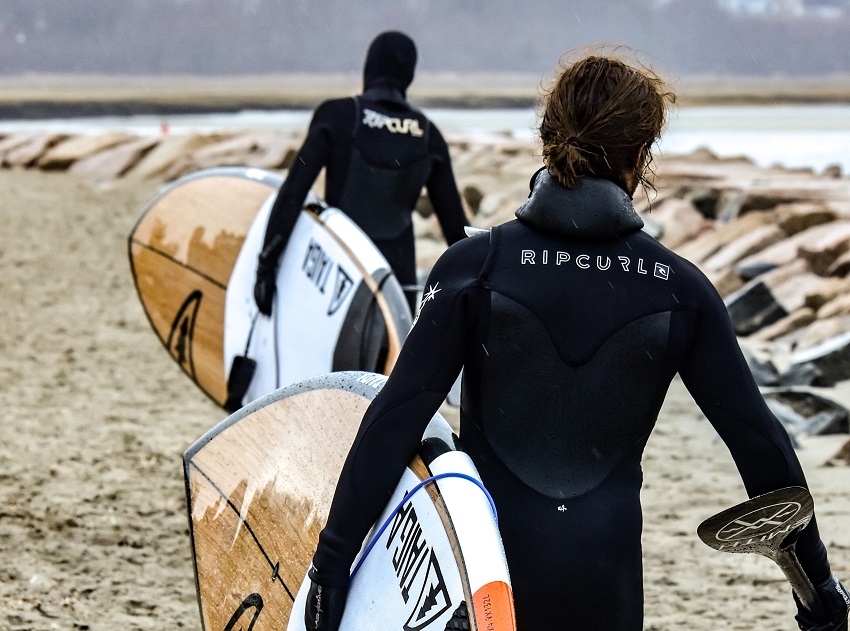
By comparison, some hard-shell paddleboards can weigh significantly more.
- Carbon fiber boards are the lightest, weighing around 25 pounds for the average single-person SUP.
- Fiberglass boards are slightly heavier, closer to 30 pounds or so for a single-person SUP.
- Plastic and wooden boards are the heaviest, typically averaging 30 pounds but rising as high as 40 pounds.
The weight of the board plays a significant role in its portability, as you’ll see below. But it also dictates how well it handles in the water (also explained below).
Capacity: Which Paddle Board Carries More Weight?
When we talk about “weight capacity” (also sometimes called “payload”), we’re talking about how much weight a paddleboard can accommodate without compromising its stability and buoyancy.
That includes not just the weight of the paddler but also the paddle, any clothing or PFD you’re wearing, the gear you’re packing, etc.
Single-person hard-shell kayaks typically have a weight capacity of around 150 to 300 pounds. The longer and wider the SUP, the higher its weight capacity.
Touring boards often have a higher weight capacity than surf SUPs, whitewater SUPs, and recreational SUPs. On a touring board, you often travel far and need to carry more gear.
However, for people like me who are a bit heavier (250 pounds to match my 6’6” frame), you’re limited in what you can carry. Even the largest hard-shell SUPs may only allow me to carry an extra 50 to 75 pounds.
Inflatable SUPs usually have a much higher weight capacity.

Because they’re filled with air, they naturally have a significantly higher buoyancy than hard-shell SUPs. They’re floating on top of the water’s surface, which means more weight is required to submerge them or compromise their stability or buoyancy.
Typically, inflatable SUPs start at a 250-pound weight capacity as an “average.” Some very small models may have a capacity closer to 200 pounds, but it’s rare.
Longer, wider, and thicker boards will have a significantly higher weight capacity—anywhere from 300 to 400 pounds. Some models (Yoga SUPs or fishing SUPs) have a weight capacity of 500 to 600 pounds.
You can see why inflatable SUPs have become more popular for people who want to paddle with or transport camping, fishing, or even hunting gear!
Performance
A few different metrics can measure the performance of a paddle board:
Speed
There’s no beating a hard-shell SUP for speed.
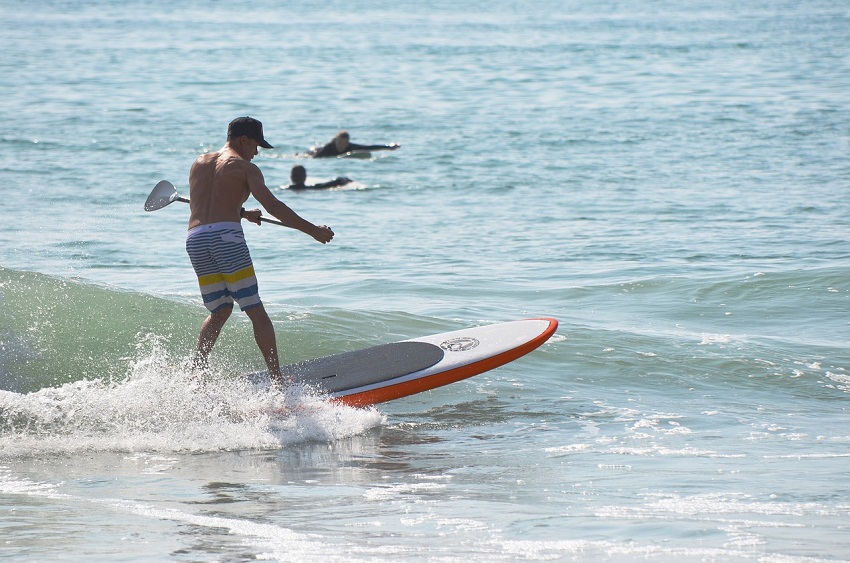
Inflatable SUPs sit on top of the water, but hard-shell SUPs are partially submerged. Though there is greater friction against the hard-shell SUPs, they feature a displacement hull design that can cut through the water more efficiently.
The rigidity of the materials used also creates a stiffer platform you can push off against with greater force, making each paddle stroke marginally more efficient.
Inflatable SUPs riding on top of the water will never be as speedy as a hard-shell SUP.
Tracking
Tracking refers to how straight the board moves through the water. This is determined by the SUP itself and by adding fins and skegs.
The very shape of the displacement hull naturally encourages straighter tracking for hard-shell boards. When fins and skegs are added (usually near the rear, but sometimes in the center of the board), it improves tracking even more.
Inflatable SUPs, on the other hand, are riding atop the water, so they’re more susceptible to currents and winds. They track less efficiently than hard-shell SUPs, even with added skegs and/or fins.
Maneuverability

Again, hard-shell SUPs take the edge on this one. They’re easier to handle and more agile because they’re partially submerged in the water.
You can make sharper and faster turns on a hard-shell SUP.
Inflatables can feel slower and tubbier. Standard maneuvers will be easy enough to execute, but you’ll never quite manage those zippy, hard turns on an inflatable SUP.
Stability
There are two types of stability, really:
- Primary stability, or the stability on flat, calm water. In this, an inflatable’s high buoyancy and light weight often win by a wide margin. Inflatables are significantly more stable than hard-shell SUPs. That’s why they’re so popular for Yoga, fishing, and recreational use.
- Secondary stability, or the ability to remain stable on choppy waters. Hard-shell SUPs have notably higher secondary stability than inflatables. Surf, racing, touring, and whitewater SUPs are all hard-shell for this reason.
Inflatable paddle boards often have better primary stability, while solid SUPs have an edge in secondary stability.
Portability
Unless you’re lucky enough to live on the shores of a lake or across the street from a beach, you’ll need to transport the paddle board to and from the water.
With hard-shell SUPs, that involves loading them up in the back of your truck or SUV (like you would a surfboard) or on the roof of your vehicle (like you would a kayak). You’ll need a roof rack or a trailer to take the board anywhere.
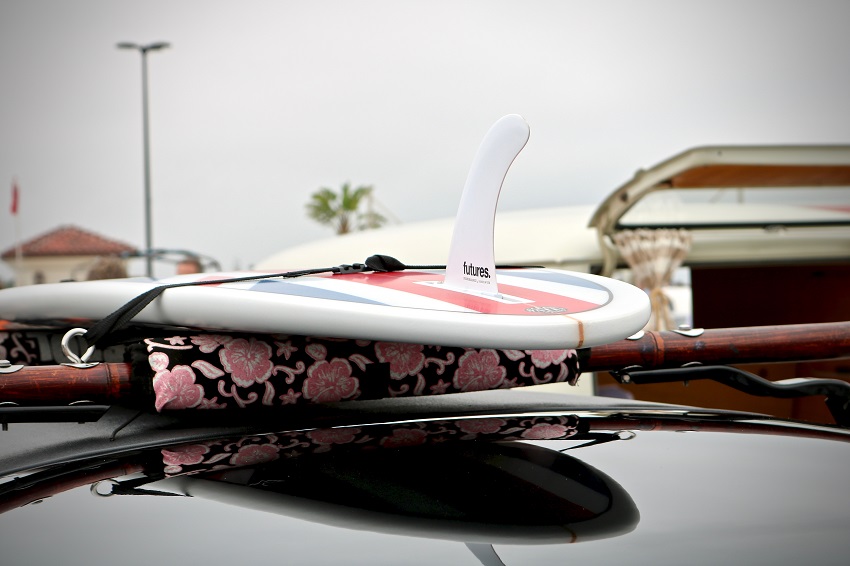
With inflatable SUPs, on the other hand, all you have to do is pack them in their carrying bag, roughly the size of a small suitcase. The bags can be thrown into the back of even a small car (I transport mine in the trunk of my Toyota Corolla and have space to spare!)—no roof rack or trailer needed.
Inflatable SUPs can also be carried on public transportation or even checked in as luggage for a flight to some vacation destination.
Therefore, inflatable paddle boards are exponentially more portable than hard-shell SUPs.
Storage
Storing a hard-shell SUP requires space in your garage or shed and a storage solution. Hard-shell SUPs can be stored standing up (like surf boards), though it may damage the ends and cause the board to buckle or bend. Really, they’re best stored on a rack or hoist.
Inflatable SUPs, on the other hand, just roll up in their little carrying bags and can be tucked into a corner of your shed, garage, attic, basement, or wherever you have space.
An Inflatable SUP is far easier to store and takes up significantly less room in your house than a hard-shell SUP.
Maintenance
We discussed the durability of hard-shell and inflatable SUPs above, so you know which materials will be more resilient and require less maintenance.
A thermoplastic/rotomolded plastic board will require almost zero upkeep or maintenance. They’ll last for years and endure all manner of scratches, dings, dents, and impacts without showing any damage. Chances are, they’ll outlast even you (and maybe the end of the world).
Epoxy and fiberglass boards are far more fragile. They can be damaged during transportation or with hard use.
Trying to do maintenance on these hard-shell boards is not an easy task. Or cheap, for that matter. You’ve got to find exactly the right material (epoxy resin or glue) and repair the damage without compromising the streamlined shape of the board.
Maintaining epoxy or fiberglass boards is better suited to experts at your local surf or SUP board repair shop.
Inflatable SUPs tend to be very low-maintenance, and what maintenance is required is usually fairly easy to carry out.
Typically, you can repair punctures or tears using PVC patches, which you can buy online. These patches come with their own adhesive to make for easy repairs. As long as you give the glue time to cure (usually 24 to 48 hours), it’ll be as good as new.
And, because you’re not too worried about things like speed or streamlining with an inflatable, you don’t have to worry that patching/repairing the board will compromise its performance.
Versatility
By their nature, inflatable SUPs tend to be far less versatile.
- They typically adhere to a few standard designs, shapes, and sizes.
- Their lower secondary stability makes them less suited to choppy or fast-flowing water.
- Their high primary stability and buoyancy make them ideal for any activity on calm flatwater: Yoga, fishing, and recreational paddling.
With hard-shell SUPs, it’s a different story.
They can come in a lot more shapes, sizes, and designs.
Surfing paddle boards, for example, will look a lot like a surfboard or longboard, while a racing board will be much narrower and sleeker. Whitewater SUPs will be crafted shorter to make speeder turns but designed to withstand impacts or collisions with obstacles.
Yoga or fishing boards may be wider to increase primary stability and feature more gear mounts or a trolling motor mount.
Inflatable SUPs have more limitations. Hard-shell paddle boards are far more versatile thanks to their variety of construction and design.
Suitability for Beginners
My first time on a paddleboard was a memorable experience—for all the wrong reasons.
I did great balancing on my knees, but when I tried to stand…well, let’s just say I found out first-hand just how cold Canadian lakes could be in early summer. Repeatedly.

It turned out the paddleboard I was using was built for a smaller, lighter paddler than I. Not knowing that, I tried repeatedly—and repeatedly failed—to stand.
But when I made the same attempt with an inflatable paddleboard with a higher weight capacity and better primary stability and buoyancy, I paddled for hours without falling once.
Hard-shell SUPs handle better and can manage faster speeds, but they’re not quite as newbie-friendly as inflatables. For first-timers, getting up and staying up on an inflatable paddleboard is much easier.
Comfort
Both hard-shell and inflatable paddleboards are typically built with soft deck pads that provide traction and cushioning beneath your feet.
But as someone who’s fallen more than a few times, I can safely say you don’t always fall onto the pad.
More often than not, you lose your balance backward or forward, and you end up hitting the board on your way overboard. And if it’s a hard-shell board, that impact can be painful with a capital P.
Inflatables, on the other hand, won’t pack quite the wallop if you fall on them. They’re softer by nature and so won’t be as painful. This is why many newbies typically opt for inflatables: they are more forgiving and less punishing when you inevitably fall.
Price
Comparing the prices of hard-shell and inflatable SUPs, it’s pretty clear which is more wallet-friendly.
On the very lowest, most budget-friendly end of the spectrum, inflatable SUPs can be found for prices as low as $200 or $300. By comparison, hard-shell boards start closer to $400.
In the mid-tier range, expect to pay anywhere from $450 to $800 for an inflatable. Hard-shell boards are a little pricier by comparison: usually from $600 to $1,000. We’re talking good build quality, solid materials, and simple designs compatible with SUP Yoga or recreational use.
When you start getting more sport-specific, that’s when things get pricier.
High-end inflatables will run you at most $800 to $1,500. It’s rare for an inflatable SUP to cross the $2,000—rare enough that I have yet to see one.
High-end hard-shell SUPs, on the other hand, start at $1,200 to $1,500 and rise as high as $3,000 or more. These are the carbon-fiber or fiberglass SUPs built for racing, touring, or fishing (loaded with tons of extra accessories).
You’ll spend more on a hard-shell SUP than an inflatable, and they’re not always guaranteed to last longer (though most will have a longer warranty backing them).
Weighing the Pros and Cons of Inflatable vs. Solid SUPs
My goal with this article isn’t to tip your opinion one way or another. I’m here to give you the facts of what makes each type of paddleboard suited to specific activities, paddlers, and uses.
To that end, I’ll share a quick recap of the pros and cons of both paddleboard types so you have a concise understanding of which will serve you best.
Solid Paddle Boards:
Inflatable Paddle Boards:
Inflatable vs. Solid Paddle Board FAQs
Most inflatable SUPs are backed by warranties of 1 and 4 years (depending on the brand), but they can last for up to 10 years or even more with proper maintenance and care.
Typically, the range is between 13 to 17 PSI. Each manufacturer will stamp their boards (and include in the provided manuals) their recommendation for the target PSI to make the board as rigid and solid as possible without damaging them by over-inflation.
In my experience, I’ve found 15 to 16 PSI to be the sweet spot for heavier paddlers (like my 250 lbs.), while 14 to 15 PSI is more than sufficient for lighter paddlers (like my wife, whose weight I am not foolish enough to post publicly).
Once, inflatable SUPs were more likely to be punctured or torn because of cheaper materials. Modern SUPs, however, are built using higher-quality materials—such as military-grade PVC and drop-stitching—that make them incredibly resilient. It takes a lot of force to puncture an inflatable SUP.
If a paddleboard does get punctured, you’ll find they’re fairly easy to repair using self-adhesive PVC patches (which you can buy online).
You can store a paddleboard inflated without damaging the structure or compromising its integrity. However, an inflated paddleboard is harder to transport and takes up more space.
It’s safe to leave the paddleboard inflated between uses. Still, it’s a good idea to deflate and pack them away properly before storing them over long weeks or months of inactivity (i.e., during the colder seasons).





